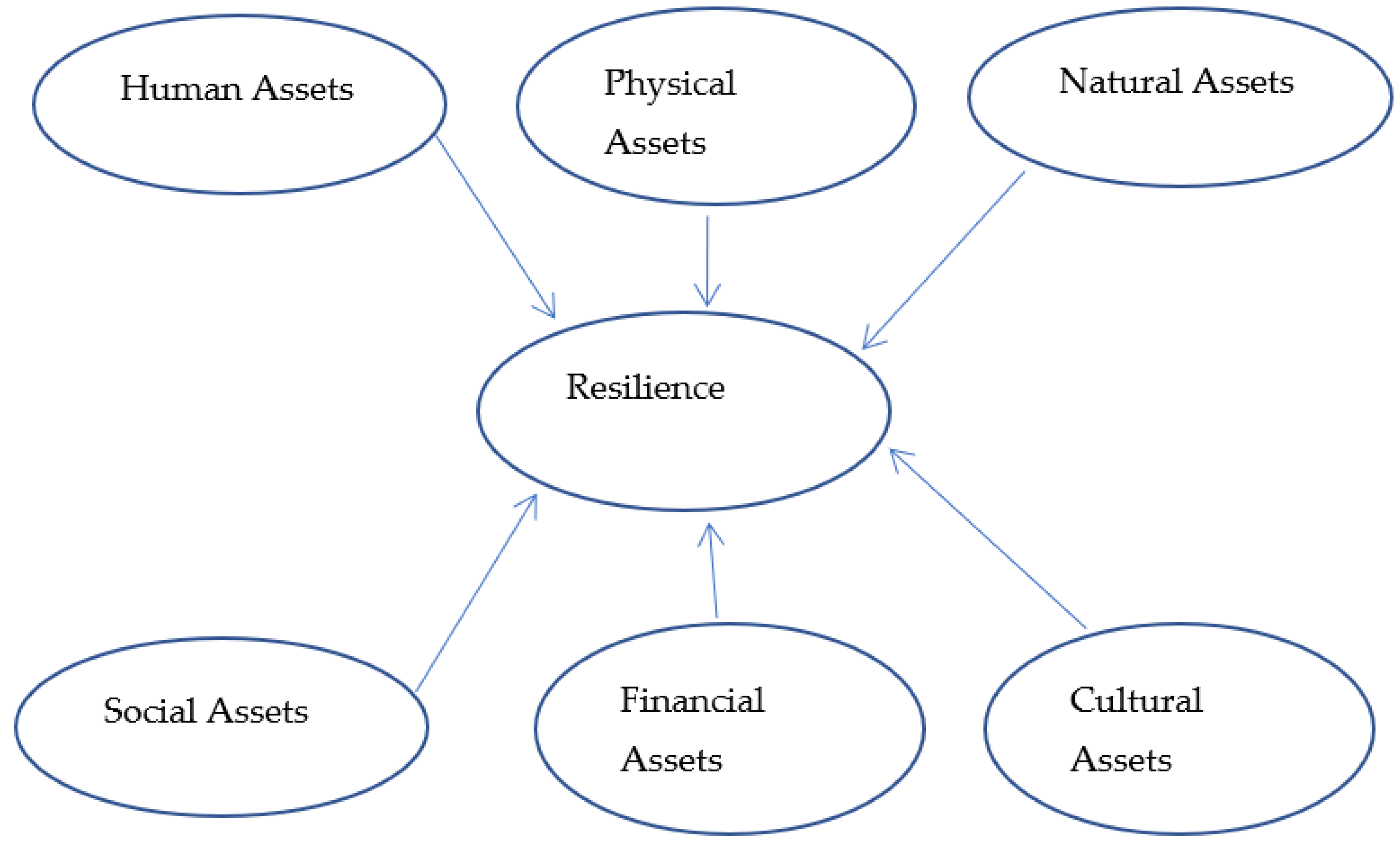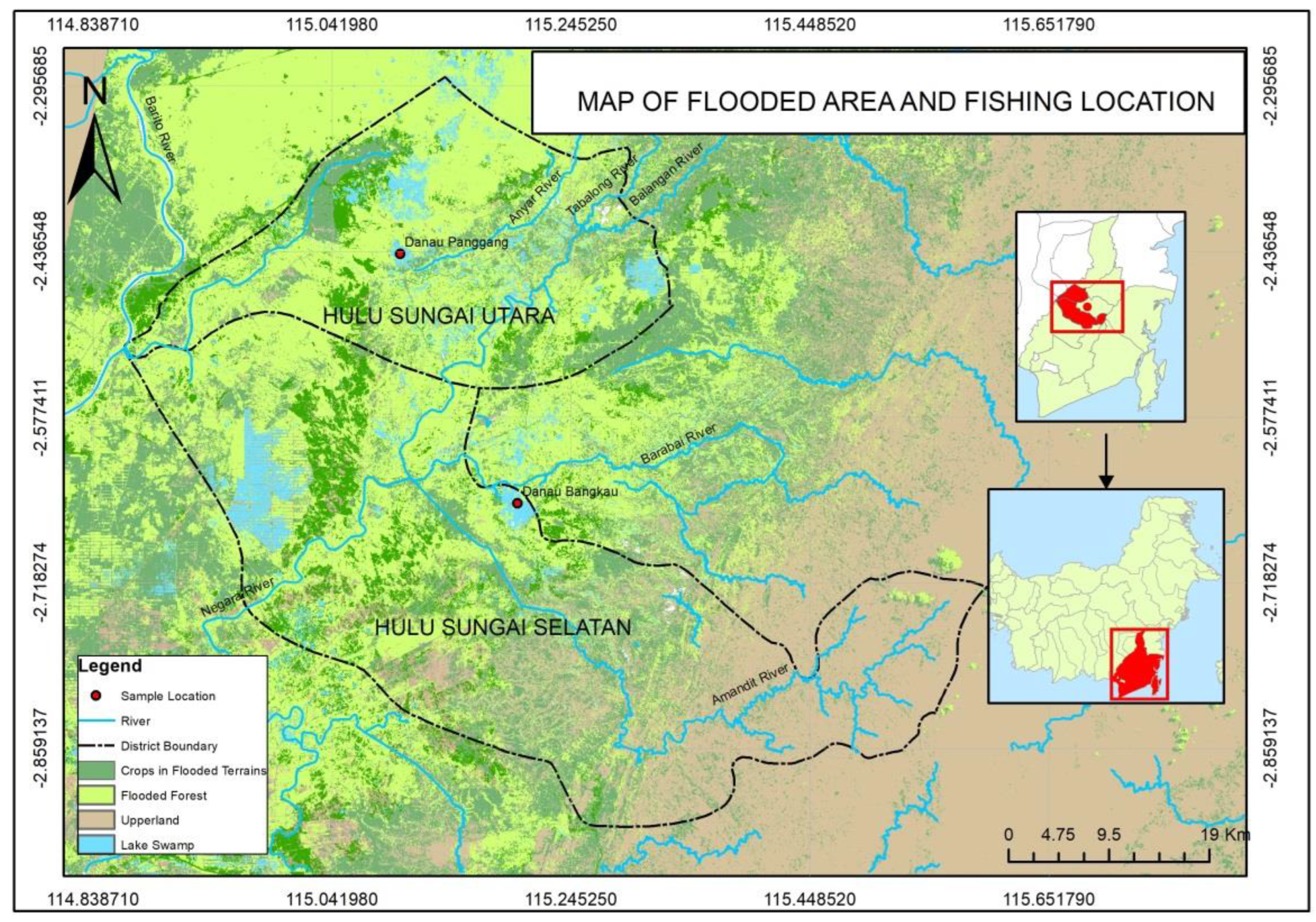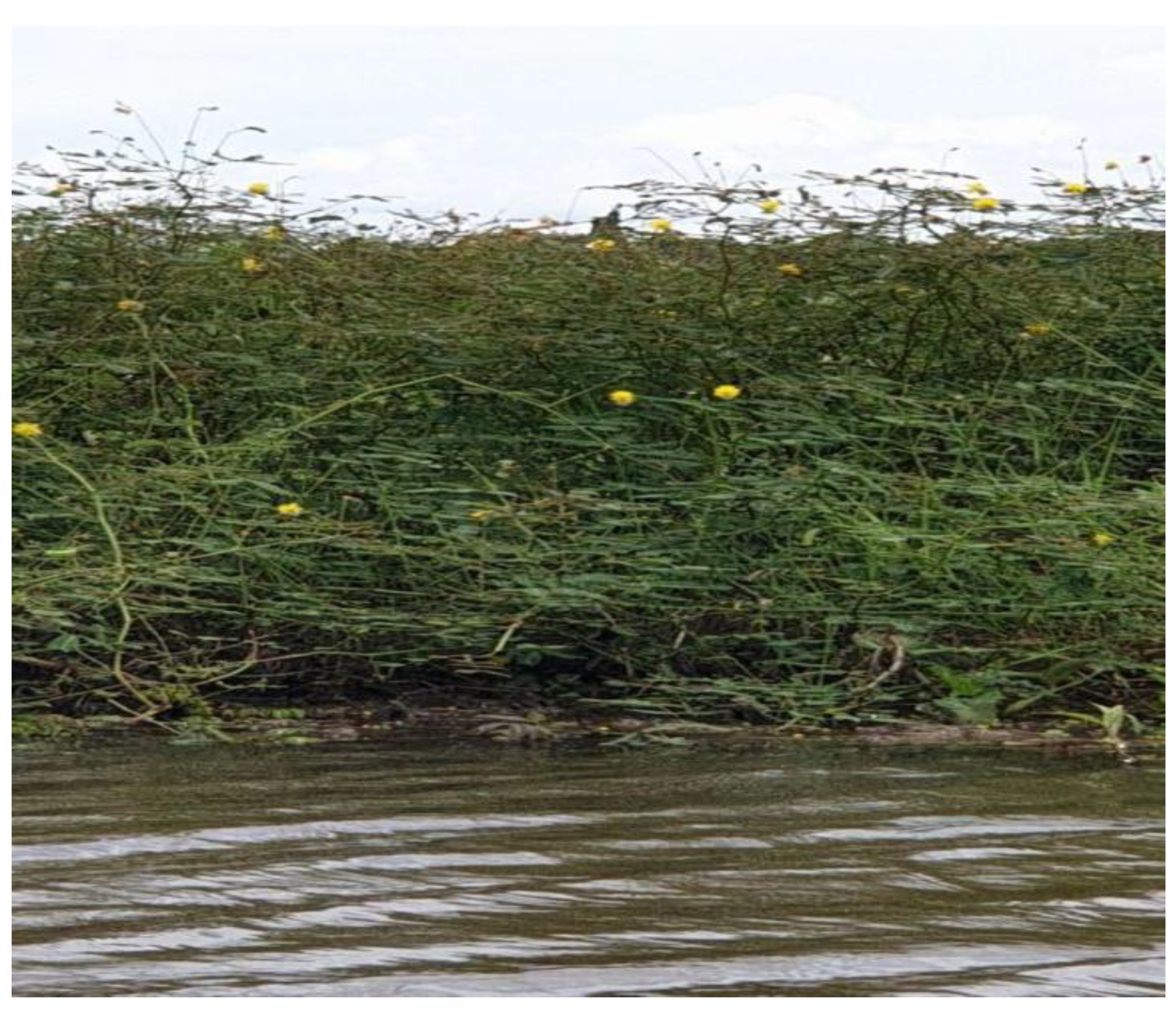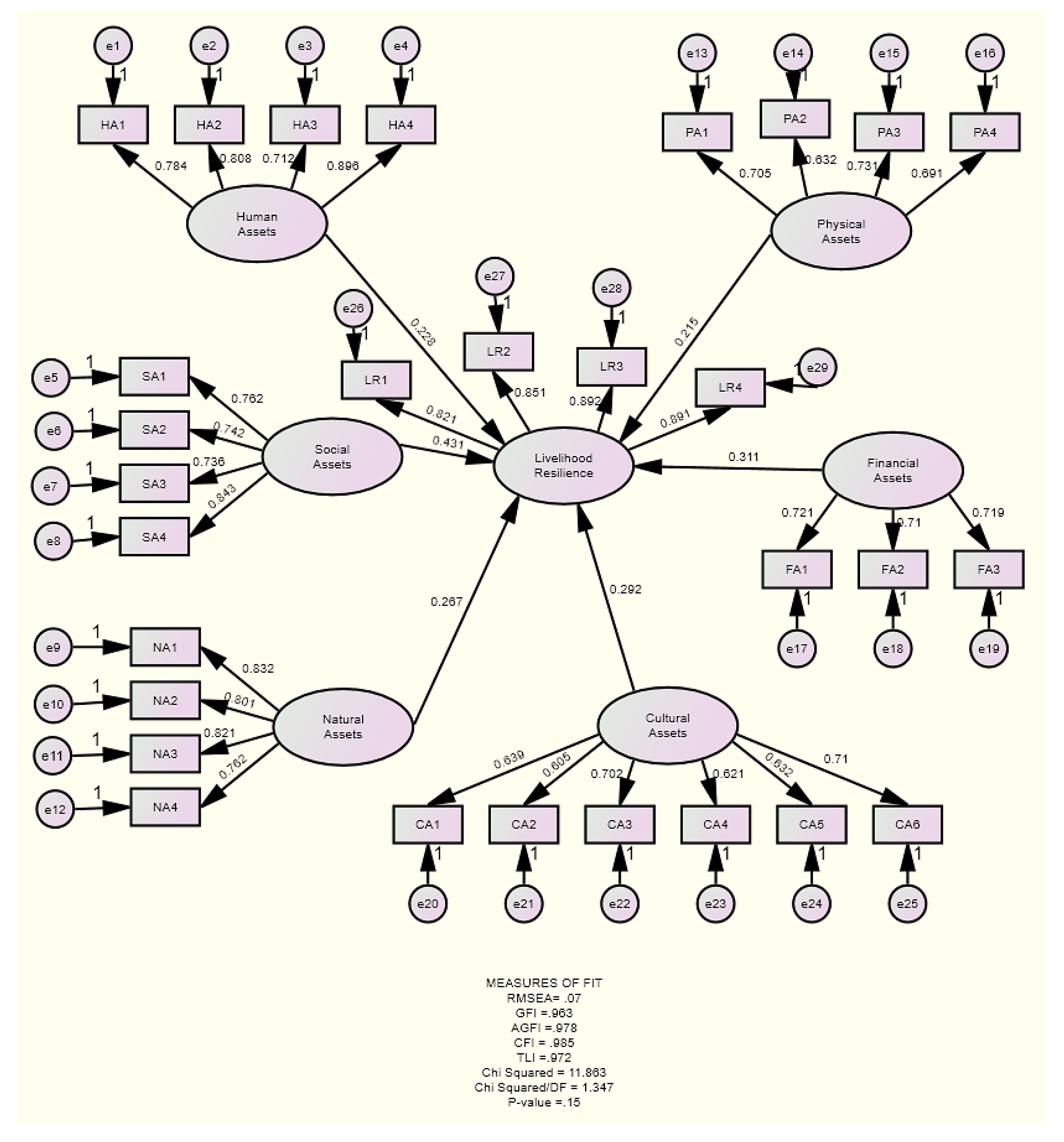Sustainability of Floodplain Wetland Fisheries of Rural Indonesia: Does Culture Enhance Livelihood Resilience?
Abstract
1. Introduction
2. Theoretical Framework and Hypotheses Development
2.1. Livelihood Resilience
2.2. Frameworks and Indicators for Measuring Livelihood Resilience
3. Materials and Methods
4. Results
4.1. Characteristics of Research Location
“Before we were poor because of no markets and no access to the financial institution.We caught lots of fish but the price was so low. Now credit and markets are available, but fish is very scarce.”(Interview, 11 August 2021.)
“When I was young, I would like to work in a mining company. But competition between local people and skilled workers from other islands who arrived around the 1980s had been very tough as we never won.We had no choice but to survive instead of coming back to fishers. Before that traditional fisher did well.”(Interview, 26 August 2021.)
4.2. Environmental Pressure on Fishing Business
4.3. Structural Model
5. Discussion
6. Conclusions
Author Contributions
Funding
Institutional Review Board Statement
Informed Consent Statement
Data Availability Statement
Acknowledgments
Conflicts of Interest
References
- Rivera, G.; Gonzales, S.; Aponte, H. Wetlands of the South American Pacific Coast: A Bibliometric Analysis. Wetl. Ecol. Manag. 2022, 30, 869–877. [Google Scholar] [CrossRef]
- Bridgewater, P.; Kim, R.E. The Ramsar Convention on Wetlands at 50. Nat. Ecol. Evol. 2021, 5, 268–270. [Google Scholar] [CrossRef]
- Chomba, I.C.; Banda, K.E.; Winsemius, H.C.; Chomba, M.J.; Mataa, M.; Ngwenya, V.; Sichingabula, H.M.; Nyambe, I.A.; Ellender, B. A Review of Coupled Hydrologic-Hydraulic Models for Floodplain Assessments in Africa: Opportunities and Challenges for Floodplain Wetland Management. Hydrology 2021, 8, 44. [Google Scholar] [CrossRef]
- Stoffers, T.; Buijse, A.D.; Geerling, G.W.; Jans, L.H.; Schoor, M.M.; Poos, J.J.; Verreth, J.A.J.; Nagelkerke, L.A.J. Freshwater Fish Biodiversity Restoration in Floodplain Rivers Requires Connectivity and Habitat Heterogeneity at Multiple Spatial Scales. Sci. Total Environ. 2022, 838, 156509. [Google Scholar] [CrossRef] [PubMed]
- Sarkar, U.K.; Karnatak, G.; Lianthuamluaia, L.; Puthiyottil, M.; das Ghosh, B.; Johnson, C.; Kumari, S.; Saha, S.; Das, B.K. Combining Stakeholder Perception and Ecological Approaches for Assessing Vulnerability of Floodplain Wetlands in Changing Climate: A Regional Study. Int. J. Biometeorol. 2022, 66, 1415–1427. [Google Scholar] [CrossRef]
- Ballut-Dajud, G.A.; Sandoval Herazo, L.C.; Fernández-Lambert, G.; Marín-Muñiz, J.L.; López Méndez, M.C.; Betanzo-Torres, E.A. Factors Affecting Wetland Loss: A Review. Land 2022, 11, 434. [Google Scholar] [CrossRef]
- Naskar, M.; Sarkar, U.K.; Mishal, P.; Karnatak, G.; Saha, S.; Bandopadhyay, A.; Bakshi, S.; das Ghosh, B.; Das, B.K. Assessing Vulnerability of Wetland Fisheries to Climate Change: A Stakeholders’ Perception-Based Approach. Clim. Dev. 2021, 14, 600–616. [Google Scholar] [CrossRef]
- Leal Filho, W.; Nagy, G.J.; Martinho, F.; Sarkar, M.; Earache, M.G.; Primo, A.L.; Pardal, M.A.; Li, C. Influences of Climate Change and Variability on Estuarine Ecosystems: An Impact Study in Selected European, South American and Asian Countries. Int. J. Env. Res. Public Health 2022, 19, 585. [Google Scholar] [CrossRef]
- Bernos, T.A.; Travouck, C.; Ramasinoro, N.; Fraser, D.J.; Mathevon, B. What Can Be Learned from Fishers’ Perceptions for Fishery Management Planning? Case Study Insights from Sainte-Marie, Madagascar. PLoS ONE 2021, 16, e0259792. [Google Scholar] [CrossRef] [PubMed]
- Shaffril, H.A.M.; Abu Samah, A.; Samsuddin, S.F. The Impacts of Fishermen’s Resilience towards Climate Change on Their Well-Being. Sustainability 2022, 14, 3203. [Google Scholar] [CrossRef]
- Syaharuddin, S.; Susanto, H.; Putra, M.A.H. Portrait of Community Economic Activities in The River as a Learning Resources on Social Studies With Local Culture-Based. Innov. Soc. Stud. J. 2020, 1, 178–187. [Google Scholar] [CrossRef]
- Usop, S.R.; Rajiani, I. Indigenous Indonesian Dayak Traditional Wisdom in Reducing Deforestation. Indones J. Geogr. 2021, 53, 310–317. [Google Scholar] [CrossRef]
- Rajiani, I.; Pypłacz, P. National Culture as Modality in Managing the Carbon Economy in Southeast Asia. Pol. J. Manag. Stud. 2018, 18, 296–310. [Google Scholar] [CrossRef]
- Thornton, S.A.; Setiana, E.; Yoyo, K.; Harrison, M.E.; Page, S.E.; Upton, C. Towards Biocultural Approaches to Peatland Conservation: The Case for Fish and Livelihoods in Indonesia. Env. Sci Policy 2020, 114, 341–351. [Google Scholar] [CrossRef]
- Muawanah, U.; de Alessi, M.; Pomeroy, R.; Kurniasari, N.; Shafitri, N.; Yulianty, C. Going into Hak: Pathways for Revitalising Marine Tenure Rights in Indonesia. Ocean Coast. Manag. 2021, 215, 105944. [Google Scholar] [CrossRef]
- Jaya, I.; Satria, F.; Nugroho, D.; Sadiyah, L.; Buchary, E.A.; White, A.T.; Franklin, E.C.; Courtney, C.A.; Green, G.; Green, S.J. Are the Working Principles of Fisheries Management at Work in Indonesia? Mar. Policy 2022, 140, 105047. [Google Scholar] [CrossRef]
- Humphries, A.; Gorospe, K.; Innes-Gold, A.; McNamee, J.; McManus, C.; Oviatt, C.; Collie, J. In Pursuit of Ecosystem-Based Management for Narragansett Bay: An Overview of Previous Models and Roadmap for Future Research. Coast. Manag. 2022, 50, 262–283. [Google Scholar] [CrossRef]
- Mason, J.G.; Eurich, J.G.; Lau, J.D.; Battista, W.; Free, C.M.; Mills, K.E.; Tokunaga, K.; Zhao, L.Z.; Dickey-Collas, M.; Valle, M. Attributes of Climate Resilience in Fisheries: From Theory to Practice. Fish Fish. 2022, 23, 522–544. [Google Scholar] [CrossRef]
- Adger, W.N.; Brown, K.; Butler, C.; Quinn, T. Social-Ecological Dynamics of Catchment Resilience. Water 2021, 13, 349. [Google Scholar] [CrossRef]
- Stacey, N.; Gibson, E.; Loneragan, N.R.; Warren, C.; Wiryawan, B.; Adhuri, D.S.; Steenbergen, D.J.; Fitriana, R. Developing Sustainable Small-Scale Fisheries Livelihoods in Indonesia: Trends, Enabling and Constraining Factors, and Future Opportunities. Mar. Policy 2021, 132, 104654. [Google Scholar] [CrossRef]
- Warren, C.; Steenbergen, D.J. Fisheries Decline, Local Livelihoods and Conflicted Governance: An Indonesian Case. Ocean Coast. Manag. 2021, 202, 105498. [Google Scholar] [CrossRef]
- Makwinja, R.; Kaunda, E.; Mengistu, S.; Alemiew, T.; Njaya, F.; Kosamu, I.B.M.; Kaonga, C.C. Lake Malombe Fishing Communities’ Livelihood, Vulnerability, and Adaptation Strategies. Curr. Res. Environ. Sustain. 2021, 3, 100055. [Google Scholar] [CrossRef]
- Su, F.; Song, N.; Ma, N.; Sultanaliev, A.; Ma, J.; Xue, B.; Fahad, S. An Assessment of Poverty Alleviation Measures and Sustainable Livelihood Capability of Farm Households in Rural China: A Sustainable Livelihood Approach. Agriculture 2021, 11, 1230. [Google Scholar] [CrossRef]
- Alpine, E.; Turner, L.M.; Rodwell, L.D.; Bhatta, R. The Application of the Sustainable Livelihood Approach to Small Scale-Fisheries: The Case of Mud Crab Scylla Serrata in South West India. Ocean Coast. Manag. 2019, 170, 17–28. [Google Scholar] [CrossRef]
- Zhang, C.; Fang, Y. Application of Capital-Based Approach in the Measurement of Livelihood Sustainability: A Case Study from the Koshi River Basin Community in Nepal. Ecol. Indic. 2020, 116, 106474. [Google Scholar] [CrossRef]
- Papa, C.; Nzokou, P.; Mbow, C. Farmer Livelihood Strategies and Attitudes in Response to Climate Change in Agroforestry Systems in Kédougou, Senegal. Env. Manag. 2020, 66, 218–231. [Google Scholar] [CrossRef]
- Kansanga, M.M.; Luginaah, I. Agrarian Livelihoods under Siege: Carbon Forestry, Tenure Constraints and the Rise of Capitalist Forest Enclosures in Ghana. World Dev. 2019, 113, 131–142. [Google Scholar] [CrossRef]
- Fabinyi, M.; Belton, B.; Dressler, W.H.; Knudsen, M.; Adhuri, D.S.; Aziz, A.A.; Akber, M.A.; Kittitornkool, J.; Kongkaew, C.; Marschke, M. Coastal Transitions: Small-Scale Fisheries, Livelihoods, and Maritime Zone Developments in Southeast Asia. J. Rural. Stud. 2022, 91, 184–194. [Google Scholar] [CrossRef]
- Ayilu, R.K.; Fabinyi, M.; Barclay, K. Small-Scale Fisheries in the Blue Economy: Review of Scholarly Papers and Multilateral Documents. Ocean Coast. Manag. 2022, 216, 105982. [Google Scholar] [CrossRef]
- Li, W.; Hsu, C.Y.; Hu, M. Tobler’s First Law in GeoAI: A Spatially Explicit Deep Learning Model for Terrain Feature Detection under Weak Supervision. Ann. Am. Assoc. Geogr. 2021, 111, 1887–1905. [Google Scholar] [CrossRef]
- Pasanchay, K.; Schott, C. Community-Based Tourism Homestays’ Capacity to Advance the Sustainable Development Goals: A Holistic Sustainable Livelihood Perspective. Tour. Manag. Perspect. 2021, 37, 100784. [Google Scholar] [CrossRef]
- Amadu, I.; Armah, F.A.; Auto, D.W.; Adongo, C.A. A Study on Livelihood Resilience in the Small-Scale Fisheries of Ghana Using a Structural Equation Modelling Approach. Ocean Coast. Manag. 2021, 215, 105952. [Google Scholar] [CrossRef]
- Nasrnia, F.; Ashktorab, N. Sustainable Livelihood Framework-Based Assessment of Drought Resilience Patterns of Rural Households of Bakhtegan Basin, Iran. Ecol. Indic. 2021, 128, 107817. [Google Scholar] [CrossRef]
- Cinner, J.E.; Barnes, M.L. Social Dimensions of Resilience in Social-Ecological Systems. One Earth 2019, 1, 51–56. [Google Scholar] [CrossRef]
- Truchet, D.M.; Buzzi, N.S.; Noceti, M.B. A “New Normality” for Small-Scale Artisanal Fishers? The Case of Unregulated Fisheries during the COVID-19 Pandemic in the Bahía Blanca Estuary (SW Atlantic Ocean). Ocean Coast. Manag. 2021, 206, 105585. [Google Scholar] [CrossRef]
- Jelinčić, D.A. Indicators for Cultural and Creative Industries’ Impact Assessment on Cultural Heritage and Tourism. Sustainability 2021, 13, 7732. [Google Scholar] [CrossRef]
- Sargani, G.R.; Jiang, Y.; Chandio, A.A.; Shen, Y.; Ding, Z.; Ali, A. Impacts of Livelihood Assets on Adaptation Strategies in Response to Climate Change: Evidence from Pakistan. Environ. Dev. Sustain. 2022, 1–24. [Google Scholar] [CrossRef]
- Solesbury, W. Sustainable Livelihoods: A Case Study of the Evolution of DFID Policy; ODI: London, UK, 2003; pp. 1–28. ISBN 0850036674. Available online: https://odi.org/en/publications/sustainable-livelihoods-a-case-study-of-the-evolution-of-dfid-policy/ (accessed on 2 July 2022).
- Soma, H.; Sukhwani, V.; Shaw, R. An Approach to Determining the Linkage between Livelihood Assets and the Housing Conditions in Urban Slums of Dhaka. J. Urban Manag. 2022, 11, 23–36. [Google Scholar] [CrossRef]
- Adebiyi, J.A.; Olabisi, L.S.; Richardson, R.; Liverpool-Tasie, L.S.O.; Delate, K. Drivers and Constraints to the Adoption of Organic Leafy Vegetable Production in Nigeria: A Livelihood Approach. Sustainability 2019, 12, 96. [Google Scholar] [CrossRef]
- Henriksen, M.G.; Englander, M.; Nordgaard, J. Methods of Data Collection in Psychopathology: The Role of Semi-Structured, Phenomenological Interviews. Phenom. Cogn. Sci. 2022, 21, 9–30. [Google Scholar] [CrossRef]
- Maxwell, J.A. Why Qualitative Methods Are Necessary for Generalisation. Qual. Psychol. 2021, 8, 111. [Google Scholar] [CrossRef]
- Schreiber, J.B.; Nora, A.; Stage, F.K.; Barlow, E.A.; King, J. Reporting Structural Equation Modeling and Confirmatory Factor Analysis Results: A Review. J. Educ. Res. 2006, 99, 323–338. [Google Scholar] [CrossRef]
- Hair, J.F.; Howard, M.C.; Nitzl, C. Assessing Measurement Model Quality in PLS-SEM Using Confirmatory Composite Analysis. J. Bus. Res. 2020, 109, 101–110. [Google Scholar] [CrossRef]
- Bonett, D.G.; Wright, T.A. Cronbach’s Alpha Reliability: Interval Estimation, Hypothesis Testing, and Sample Size Planning. J. Organ. Behav. 2015, 36, 3–15. [Google Scholar] [CrossRef]
- Kamaruddin, R.; Samsudin, S. The Sustainable Livelihoods Index: A Tool to Assess the Ability and Preparedness of the Rural Poor in Receiving Entrepreneurial Project. J. Soc. Econ. Res. 2014, 1, 108–117. [Google Scholar]
- Ford, J.D.; King, N.; Galappaththi, E.K.; Pearce, T.; McDowell, G.; Harper, S.L. The Resilience of Indigenous Peoples to Environmental Change. One Earth 2020, 2, 532–543. [Google Scholar] [CrossRef]
- Alavi, M.; Visentin, D.C.; Thapa, D.K.; Hunt, G.E.; Watson, R.; Cleary, M.L. Chi-Square for Model Fit in Confirmatory Factor Analysis. JAN Lead. Glob. Nurs. Res. 2020, 76, 2209–2211. [Google Scholar] [CrossRef]
- Hu, L.; Bentler, P.M. Cutoff Criteria for Fit Indexes in Covariance Structure Analysis: Conventional Criteria versus New Alternatives. Struct. Equ. Model. 1999, 6, 1–55. [Google Scholar] [CrossRef]
- Arbuckle, J.L. IBM SPSS Amos 23 User’s Guide; Amos Development Corporation: Crawfordville, FL, USA, 2014; pp. 1–702. ISBN 9781526402257. Available online: https://www.ibm.com/support/pages/ibm-spss-amos-23-documentation/ (accessed on 2 July 2022).
- Sutrisno, E. The Legal Problem of Using Non Environmentally Friendly Fishing Gear in the Fisher Community of Indonesia. Eurasian J. Biosci. 2019, 13, 2105–2109. [Google Scholar]
- Segbefia, A.Y.; Honlah, E.; Appiah, D.O. Effects of Water Hyacinth Invasion on Sustainability of Fishing Livelihoods along the River Tano and Abby-Tano Lagoon, Ghana. Cogent Food Agric. 2019, 5, 1654649. [Google Scholar] [CrossRef]
- Halim, A.; Wiryawan, B.; Loneragan, N.R.; Hordyk, A.; Sondita, M.F.A.; White, A.T.; Koeshendrajana, S.; Ruchimat, T.; Pomeroy, R.S.; Yuni, C. Developing a Functional Definition of Small-Scale Fisheries in Support of Marine Capture Fisheries Management in Indonesia. Mar. Policy 2019, 100, 238–248. [Google Scholar] [CrossRef]
- Purwanto, S.A. Back to the River. Changing Livelihood Strategies in Kapuas Hulu, West Kalimantan, Indonesia. For. Trees Livelihoods 2018, 27, 141–157. [Google Scholar] [CrossRef]
- Nugroho, H.Y.S.H.; Indrawati, D.R.; Wahyuningrum, N.; Adi, R.N.; Supangat, A.B.; Indrajaya, Y.; Putra, P.B.; Cahyono, S.A.; Nugroho, A.W.; Basuki, T.M. Toward Water, Energy, and Food Security in Rural Indonesia: A Review. Water 2022, 14, 1645. [Google Scholar] [CrossRef]
- Kaluma, K.; Umar, B.B. Outcomes of Participatory Fisheries Management: An Example from Co-Management in Zambia’s Mweru-Luapula Fishery. Heliyon 2021, 7, e06083. [Google Scholar] [CrossRef] [PubMed]
- Reed, G.; Brunet, N.D.; Natcher, D.C. Can Indigenous Community-Based Monitoring Act as a Tool for Sustainable Self-Determination? Extra Ind. Soc. 2020, 7, 1283–1291. [Google Scholar] [CrossRef]
- Albornoz, C.; Glückler, J. Co-Management of Small-Scale Fisheries in Chile From a Network Governance Perspective. Environments 2020, 7, 104. [Google Scholar] [CrossRef]
- Hukom, V.; Nielsen, R.; Nielsen, M. Effects of Co-Management on Technical Efficiency and Environmental Stressors: An Application to Small-Scale Shrimp Polyculture in Indonesia. Aquac. Econ. Manag. 2022, 26, 98–117. [Google Scholar] [CrossRef]
- Iqbal, M. Arsyad Al-Banjari’s for Integrating Banjarese Traditions into Islamic Law. In Arsyad al-Banjari’s Insights on Parallel Reasoning and Dialectic in Law; Springer: Berlin/Heidelberg, Germany, 2022; pp. 179–221. [Google Scholar]
- de Jong, E.B.P.; Kuipers, K. Perceptions of Change: Adopting the Concept of Livelihood Styles for a More Inclusive Approach to ‘Building with Nature’. Sustainability 2020, 12, 10011. [Google Scholar] [CrossRef]
- Lejano, R.P. Relationality and Social-Ecological Systems: Going beyond or behind Sustainability and Resilience. Sustainability 2019, 11, 2760. [Google Scholar] [CrossRef]




| Variable | Labels | Statements | Source |
|---|---|---|---|
| Human Assets | HA1 | Most family members have been in college. I have been an angler for a long time. I have sufficient knowledge of fishing in floodplain wetlands. I know how to obtain assistance from the government or local agencies to support my livelihood source. | [46] |
| HA2 | |||
| HA3 | |||
| HA4 | |||
| Social Assets | SA1 | My opinion is always taken into consideration in my community. I have been actively involved in small-scale fishery organisation. I have a delicate relationship with officials from government agencies responsible for assistance during hard times. I usually participate in activities conducted by a political party. | [46] |
| SA2 | |||
| SA3 | |||
| SA4 | |||
| Natural Assets | NA1 | The area of floodplain fishing sites is wide. I have my ponds to fish. Floodplain wetlands have a variety of fish. The number of fish caught has decreased recently. | [33] |
| NA2 | |||
| NA3 | |||
| NA4 | |||
| Physical Assets | PA1 | The fishing site is accessible by land and water. The land and water transportation pool are near my house. All fisherfolk have full access to floodplain fishing sites. I have the necessary equipment to fish in floodplain wetlands. | [33] |
| PA2 | |||
| PA3 | |||
| PA4 | |||
| Financial Assets | FA1 | My income from fishing is enough to cover my daily needs. Besides as an angler, I also make money by doing other jobs. I received social aid from the government. | [46] |
| FA2 | |||
| FA3 | |||
| Cultural Assets | CA1 | Closeness to this place promotes resilience to environmental change. We have understandings, skills, and philosophies developed by societies with a long interaction with natural environments. We can produce, grasp, and manage new information on adverse situations. The ability of our people enables us to control events affecting socio-economic conditions. We follow established norms, rules, and organisations derived from social interaction guiding which actions are obligatory, tolerable, or prohibited. It is common for us to sit together to discuss agreed objectives. | [47] |
| CA2 | |||
| CA3 | |||
| CA4 | |||
| CA5 | |||
| CA6 | |||
| Livelihood Resilience | LR1 | We are concerned with the safety of food and drinking water. Besides fishing, we farm. We are aware of environmental protection and ecological values. We have a high sense of belonging and pride in community and home. | [23] |
| LR2 | |||
| LR3 | |||
| LR4 |
| Construct | Items | Loading Factors | Cronbach’s alpha |
|---|---|---|---|
| Human Assets | HA1 | 0.784 | 0.802 |
| HA2 | 0.808 | 0.712 | |
| HA3 | 0.712 | 0.810 | |
| HA4 | 0.809 | 0.731 | |
| Social Assets | SA1 | 0.762 | 0.831 |
| SA2 | 0.742 | 0.759 | |
| SA3 | 0.736 | 0.779 | |
| SA4 | 0.843 | 0.805 | |
| Natural Assets | NA1 | 0.832 | 0.861 |
| NA2 | 0.801 | 0.823 | |
| NA3 | 0.821 | 0.850 | |
| NA4 | 0.762 | 0.872 | |
| Physical Assets | PA1 | 0.705 | 0.717 |
| PA2 | 0.632 | 0.724 | |
| PA3 | 0.731 | 0.801 | |
| PA4 | 0.691 | 0.790 | |
| Financial Assets | FA1 | 0.721 | 0.710 |
| FA2 | 0.710 | 0.704 | |
| FA3 | 0.719 | 0.821 | |
| Cultural Assets | CA1 | 0.639 | 0.721 |
| CA2 | 0.605 | 0.732 | |
| CA3 | 0.702 | 0.711 | |
| CA4 | 0.621 | 0.760 | |
| CA5 | 0.632 | 0.703 | |
| CA6 | 0.710 | 0.724 | |
| Livelihood Resilience | LR1 | 0.821 | 0.814 |
| LR2 | 0.851 | 0.864 | |
| LR3 | 0.892 | 0.875 | |
| LR4 | 0.891 | 0.892 |
| Variables | N | Mean | Std. Error |
|---|---|---|---|
| Human Assets | 550 | 2.03 | 0.533 |
| Social Assets | 550 | 3.04 | 0.401 |
| Natural Assets | 550 | 1.98 | 0.730 |
| Physical Assets | 550 | 3.08 | 0.413 |
| Financial Assets | 550 | 2.18 | 0.352 |
| Cultural Assets | 550 | 4.5 | 0.305 |
| Livelihood Resilience | 550 | 3.01 | 0.202 |
| Construct | Estimate | CR | P | Conclusion |
|---|---|---|---|---|
| Human Assets to Livelihood Resilience | 0.228 | 2.121 | 0.005 | Significant |
| Social Assets to Livelihood Resilience | 0.431 | 3.620 | 0.001 | Significant |
| Natural Assets to Livelihood Resilience | 0.267 | 2.176 | 0.005 | Significant |
| Physical Assets to Livelihood Resilience | 0.215 | 2.103 | 0.005 | Significant |
| Financial Assets to Livelihood Resilience | 0.311 | 2.981 | 0.003 | Significant |
| Cultural Assets to Livelihood Resilience | 0.292 | 2.224 | 0.004 | Significant |
Publisher’s Note: MDPI stays neutral with regard to jurisdictional claims in published maps and institutional affiliations. |
© 2022 by the authors. Licensee MDPI, Basel, Switzerland. This article is an open access article distributed under the terms and conditions of the Creative Commons Attribution (CC BY) license (https://creativecommons.org/licenses/by/4.0/).
Share and Cite
Hidayat, A.S.; Rajiani, I.; Arisanty, D. Sustainability of Floodplain Wetland Fisheries of Rural Indonesia: Does Culture Enhance Livelihood Resilience? Sustainability 2022, 14, 14461. https://doi.org/10.3390/su142114461
Hidayat AS, Rajiani I, Arisanty D. Sustainability of Floodplain Wetland Fisheries of Rural Indonesia: Does Culture Enhance Livelihood Resilience? Sustainability. 2022; 14(21):14461. https://doi.org/10.3390/su142114461
Chicago/Turabian StyleHidayat, Achmad Syamsu, Ismi Rajiani, and Deasy Arisanty. 2022. "Sustainability of Floodplain Wetland Fisheries of Rural Indonesia: Does Culture Enhance Livelihood Resilience?" Sustainability 14, no. 21: 14461. https://doi.org/10.3390/su142114461
APA StyleHidayat, A. S., Rajiani, I., & Arisanty, D. (2022). Sustainability of Floodplain Wetland Fisheries of Rural Indonesia: Does Culture Enhance Livelihood Resilience? Sustainability, 14(21), 14461. https://doi.org/10.3390/su142114461







